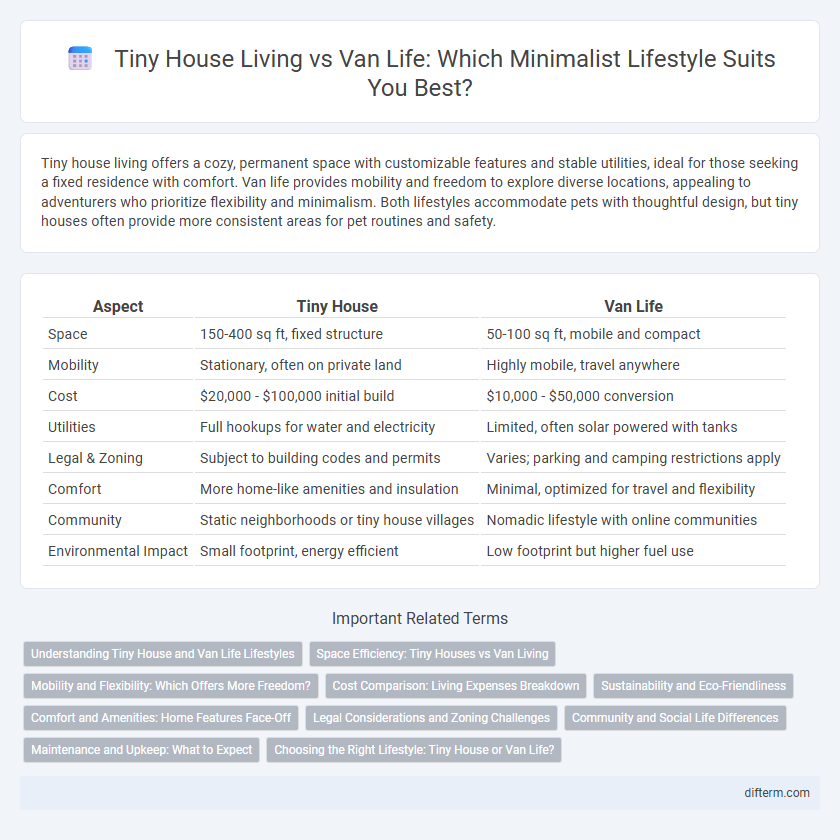Tiny house living offers a cozy, permanent space with customizable features and stable utilities, ideal for those seeking a fixed residence with comfort. Van life provides mobility and freedom to explore diverse locations, appealing to adventurers who prioritize flexibility and minimalism. Both lifestyles accommodate pets with thoughtful design, but tiny houses often provide more consistent areas for pet routines and safety.
Table of Comparison
| Aspect | Tiny House | Van Life |
|---|---|---|
| Space | 150-400 sq ft, fixed structure | 50-100 sq ft, mobile and compact |
| Mobility | Stationary, often on private land | Highly mobile, travel anywhere |
| Cost | $20,000 - $100,000 initial build | $10,000 - $50,000 conversion |
| Utilities | Full hookups for water and electricity | Limited, often solar powered with tanks |
| Legal & Zoning | Subject to building codes and permits | Varies; parking and camping restrictions apply |
| Comfort | More home-like amenities and insulation | Minimal, optimized for travel and flexibility |
| Community | Static neighborhoods or tiny house villages | Nomadic lifestyle with online communities |
| Environmental Impact | Small footprint, energy efficient | Low footprint but higher fuel use |
Understanding Tiny House and Van Life Lifestyles
Tiny house living offers a stationary lifestyle with a focus on minimalism, efficient use of space, and sustainable materials, often appealing to those seeking a stable community and a smaller ecological footprint. Van life embraces mobility and freedom, allowing individuals to travel extensively while living in a converted vehicle equipped with essentials, favoring adaptability and exploration. Both lifestyles prioritize downsizing possessions and simplifying routines, but they cater to different needs: permanence versus mobility.
Space Efficiency: Tiny Houses vs Van Living
Tiny houses maximize space efficiency through custom-built, multi-functional furniture and vertical storage solutions, offering up to 400 square feet of optimized living area. Van life requires creative compactness, utilizing foldable fixtures and under-bed storage within an average 70-square-foot space. While tiny houses provide more room for amenities, van living excels in mobility and efficient use of limited space.
Mobility and Flexibility: Which Offers More Freedom?
Van life offers unparalleled mobility with the ability to travel and park almost anywhere, providing instant access to diverse environments and spontaneous adventures. Tiny houses, while more stable and comfortable, are generally stationary or require significant effort and cost to relocate, limiting flexibility in frequent movement. For those prioritizing freedom through constant travel and adaptability, van life clearly outpaces tiny houses in delivering full mobility and an ever-changing lifestyle.
Cost Comparison: Living Expenses Breakdown
Tiny house living typically involves fixed costs such as mortgage or land rent, utilities averaging $150 to $300 monthly, and maintenance expenses around $50 to $100. Van life presents variable expenses including fuel costs averaging $100 to $300 monthly, campsite fees between $0 and $40 per night, and increased maintenance costs due to vehicle wear, usually $100 to $200 per month. Overall, tiny houses often offer more predictable living expenses, while van life fluctuates with travel frequency and fuel prices.
Sustainability and Eco-Friendliness
Tiny houses typically have a smaller carbon footprint due to their fixed location and efficient use of space, often incorporating solar panels, rainwater collection, and sustainable materials. Van life emphasizes mobility and minimalist living, relying on limited energy sources like portable solar systems and promoting reduced consumption through downsizing possessions. Both lifestyles support eco-friendliness by minimizing waste and encouraging mindful resource use, though tiny houses may offer greater potential for renewable energy integration and sustainable infrastructure.
Comfort and Amenities: Home Features Face-Off
Tiny houses offer fixed, well-insulated living spaces with full-sized kitchens, bathrooms, and comfortable furniture, providing a home-like environment with reliable utilities. Van life prioritizes mobility, featuring compact, multi-functional amenities like fold-out beds and portable cooking setups, but often sacrifices space and comfort for versatility. Both lifestyles emphasize minimalist living, but tiny houses excel in permanent comfort while vans cater to adventurous flexibility.
Legal Considerations and Zoning Challenges
Tiny house living faces strict zoning laws that vary widely by municipality, often limiting permanent placement or requiring costly permits. Van life enthusiasts encounter fewer zoning restrictions but must navigate laws prohibiting overnight parking and habitation in certain areas, especially urban centers. Both lifestyles demand thorough research of local ordinances to avoid fines and ensure compliance with residential codes and public land use regulations.
Community and Social Life Differences
Tiny house living fosters a close-knit community where neighbors often share resources, organize events, and support one another, creating a stable social network. Van life offers a more fluid social experience, with connections formed organically on the road through van life meetups, festivals, and online networks but lacks long-term community roots. Social interactions in tiny house communities tend to be more consistent and localized, while van life embraces a dynamic, transient social lifestyle centered around travel and exploration.
Maintenance and Upkeep: What to Expect
Tiny house maintenance involves regular inspections of plumbing, electrical systems, and structural integrity to prevent costly repairs, while van life upkeep centers around vehicle engine health, tire condition, and fluid levels to ensure mobility and safety. Tiny homes may require more attention to insulation and weatherproofing, whereas vans demand frequent checks on battery systems and mechanical components due to constant travel. Understanding these distinct needs helps in planning budgets and time commitment for each lifestyle choice.
Choosing the Right Lifestyle: Tiny House or Van Life?
Choosing between a tiny house and van life depends on your preferences for mobility, space, and lifestyle flexibility. Tiny houses offer more living space and stability, ideal for those seeking a permanent, cozy home with customizable features. Van life provides ultimate freedom and minimalism, perfect for travelers prioritizing adventure and mobility over square footage.
Tiny House vs Van Life Infographic

 difterm.com
difterm.com